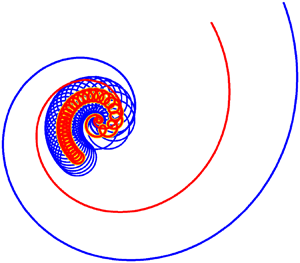Published online by Cambridge University Press: 26 January 2021

Group scattering of an initially compact two-dimensional configuration of N point vortices with strengths of different signs in an unbounded ideal fluid is investigated. This phenomenon manifests itself in a permanent increase of the vortex cloud, accompanied by mixing, clustering and emission of vortices. Possible mechanisms for such an evolution are considered, and the necessary condition is formulated. An invariant function of relative motion, F, is introduced, which is a combination of the first integrals of the system and can be expressed through 2(N−2) independent phase variables. We use this function to construct vortex equilibria and to investigate their nonlinear stability. Cases of N = 3 and N = 5 (for vortex configurations which possess central symmetry), when F depends on two variables only, are examined in detail. In addition to the familiar self-similar scattering (or collapse), we found a regime of asymptotically self-similar scattering (but not collapse) which occurs from any trajectory inside a certain finite domain in the phase space. A similar domain exists also for the case of dipole emission. A periodic absolute motion consisting of alternating stages of expansion and convergence of vortices is discussed. These mechanisms also work during group scattering. Simple examples of this phenomenon are given for the case of five vortices. Finally, group scattering is demonstrated for an initially compact cloud of 1009 vortices with strengths randomly distributed in the range (−1, 1). The area of the main part of the vortex cloud grows with time according to an almost linear law characteristic of self-similar motion.